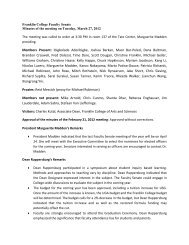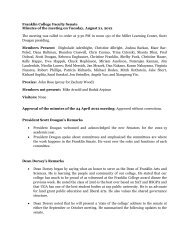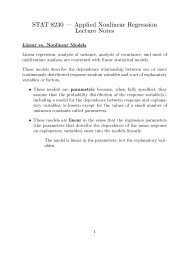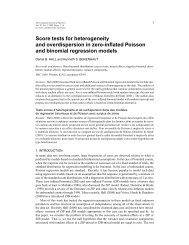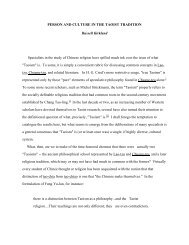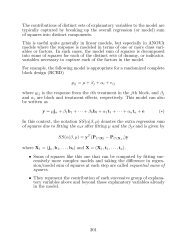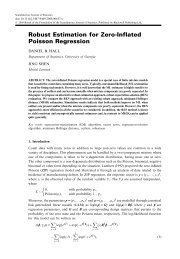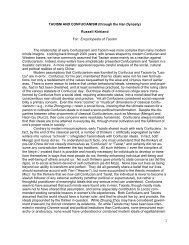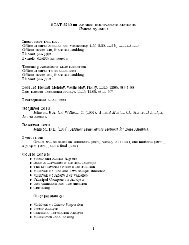Two-component mixtures of generalized linear mixed effects models ...
Two-component mixtures of generalized linear mixed effects models ...
Two-component mixtures of generalized linear mixed effects models ...
You also want an ePaper? Increase the reach of your titles
YUMPU automatically turns print PDFs into web optimized ePapers that Google loves.
28 DB Hall and L Wang<br />
obtain m <strong>linear</strong> predictors in each <strong>component</strong>: Z 1ij‘ ¼ xT ij a þ b 1‘<br />
, ‘ ¼ 1; ...; m, and<br />
Z 2ij‘ ¼ zT ij b þ b 2‘ , ‘ ¼ 1; ...; m, with unknown masses p ¼ (p 1; ...; p m ) T . The parameters<br />
b 1, b 2, and p describing the mixing distribution are regarded as nuisance<br />
parameters, with interest centered on the regression parameters a, b and c.<br />
To describe the EM algorithm for NPML, redefine d (a; s 1 ; b 1; b; s 2 ; b 2; c) T . Then<br />
the E step yields Q(d; pjd (h) ; p (h) ), given by [cf. Equation (3.3)]<br />
X<br />
X m<br />
i;j<br />
þ Xm<br />
‘¼1<br />
‘¼1<br />
þ Xm<br />
‘¼1<br />
w (h)<br />
i‘ [u(h) ij<br />
(b (h)<br />
1 ; b (h)<br />
2 ) log p ij (c) þ {1 u (h)<br />
ij<br />
(b (h)<br />
1 ; b (h)<br />
2 )} log {1 p ij (c)}]<br />
w (h)<br />
i‘ u(h) ij<br />
(b (h)<br />
1 ; b (h)<br />
2 ) log f 1 (y ij jb i ; ~a; s 1 )<br />
<br />
w (h)<br />
i‘<br />
{1 u(h)<br />
ij<br />
(b (h)<br />
1 ; b (h)<br />
2 )} log f 2 (y ij jb i ; b; ~ s 2 ) þ XC X m<br />
w (h)<br />
i‘ log (p ‘) (3:4)<br />
i¼1 ‘¼1<br />
where w (h)<br />
i‘<br />
¼ f (y i jb (h)<br />
1‘ ; b(h) 2‘ ; d(h) )p (h)<br />
‘ 0 ¼1 f (y i jb(h) 1‘<br />
; b (h)<br />
0 2‘<br />
; d (h) )p (h)<br />
0 ‘<br />
0 . Comparing the<br />
earlier expression for Q(d; pjd (h) ; p (h) ) to Equation (3.3), we see that we have almost<br />
the same form, with just an extra term for p in Equation (3.4). Therefore, the M step<br />
proceeds along the same lines as described previously.<br />
M Step for c. This can be done by fitting a weighted binomial regression <strong>of</strong> the<br />
u (h)<br />
ij<br />
(b (h)<br />
1 ; b (h)<br />
2 )’s on W i 1 m with weights w (h)<br />
i‘ .<br />
M Step for a; s 1 ; b 1. Let X ¼ [(X 1 m ); I n 1 N ]. Then maximization with respect<br />
to a, s 1 and b 1 consists <strong>of</strong> fitting a weighted GLM with mean g1 1{X<br />
(a T ; b T<br />
1 ) T },<br />
response vector y 1 m and weight w (h)<br />
i‘ u(h) ij<br />
(b 1‘ ; b 2‘<br />
) corresponding to the (i; j;‘)th<br />
element <strong>of</strong> the response vector.<br />
M Step for b; s 2 ; b 2. Again, we fit a weighted GLM based on the expanded data set.<br />
The design matrix in this regression is Z ¼ [(Z 1 m ); I n 1 N ], the mean function is<br />
g2 1(Z<br />
[b T ; b T<br />
2 ] T ), the response vector is y 1 m and the weight associated with the<br />
(i; j;‘)th response is w (h)<br />
i‘<br />
{1 u(h)<br />
ij<br />
(b 1‘ ; b 2‘ )}.<br />
M Step for p. Maximization with respect to p can be done by maximizing the fourth<br />
term <strong>of</strong> Equation (3.4). This maximization yields the closed form solution<br />
p (hþ1)<br />
‘ ¼ P C<br />
i¼1 w(h) i‘<br />
=C, ‘ ¼ 1; ...; m.<br />
Extension to more than one dimensional random <strong>effects</strong> is straightforward. In that case,<br />
the <strong>linear</strong> predictors for the two <strong>component</strong>s take the form Z 1ij ¼ x T ij a þ UT 1ijD T=2<br />
1<br />
b 1i and<br />
Z 2ij ¼ z T ij b þ UT 2ijD T=2<br />
2<br />
b 2i , respectively. Note that we have dropped the U T 3ijD T=2<br />
3<br />
b 1i term<br />
from Z 2ij here [cf. model (2.1)]. However, in the NPML approach no assumption (such as<br />
independence) concerning the joint distribution <strong>of</strong> D T=2<br />
1<br />
b 1i and D T=2<br />
2<br />
b 2i is imposed, so<br />
correlation between the two <strong>linear</strong> predictors is permitted automatically and the term<br />
U T 3ijD T=2<br />
3<br />
b 1i becomes unnecessary. Again, NPML estimation results in m <strong>linear</strong> predictors<br />
per <strong>component</strong> with masses p ¼ (p 1 ; ...; p m ) T : Z 1ij ¼ x T ij a þ UT ij b 1‘, Z 2ij ¼ z T ij b þ UT ij b 2‘,<br />
‘ ¼ 1; ...; m, where the b k‘s are unknown q k -dimensional parameters to be estimated.<br />
Note that although it may be necessary to choose a larger value <strong>of</strong> m to capture the joint<br />
distribution <strong>of</strong> b ki when q k > 1, the computational effort when using NPML increases<br />
‘ =P m



